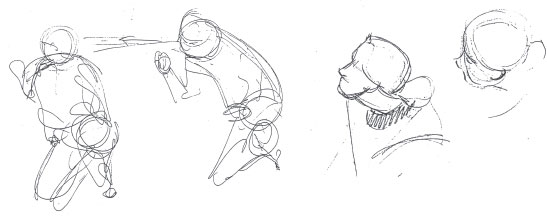54 Sometimes I Wonder Why I Spend the Lonely Hours…
In a sense, drawing is learned by accumulating a visual vocabulary, just as speaking requires a verbal vocabulary. And as a certain amount of sentence structure, syntax, and voice inflection must be learned to communicate verbally, so must there be some rules of drawing that need to be learned and used to communicate the meanings of your drawings. We think of communication as “normal,” but in the distant past there were no words, and at that point man had limited ways to communicate his thoughts — simple as they probably were. Our present way of communication has evolved … and is still evolving. In our class we’re attempting to make another leap in drawing communication by seeing the gesture at once and putting it down in all its freshness and lucidity.
It is not an easy thing to do. You have studied anatomy and have spent many hours admiring your favorite artists until a foregone conclusion as to how to draw something sets in. Now you are bombarded with new gestures and new concepts. You are called upon to see the essence of the gesture and get it down before it slides back into a watered-down pose or before your foregone conclusions alter your newfound vision.
Before I get into specifics, let me congratulate you for your recent accomplishments. Your drawings in the last class were superb.
One thing most of you have to work on is angles. You still have that subconscious desire to straighten things up.
Try this experiment: hum a couple of your favorite tunes. Notice the angles the melody takes. If you took out or straightened out those angles where would the melody be? You would end up with a kind of monotone. The same thing can happen to your drawings if all the angles are straightened out.

Music is a linear or two-dimensional thing, it moves along in one direction-while drawing, illusion-wise, is three dimensional, adding to the problem. But through a creative use of the principles of drawing, the most difficult and subtlest gestures are within your grasp. Not stiff drawings, as if done by formulae, but loose and fluid and meaningful.
Here are two corrections I saved from the class. They have to do with angles, which unlike melody, which is two-dimensional, are three-dimensional and come at us from all directions. Two of the simple rules of perspective, overlap, and surface lines are applicable here.
Notice how the male figure stooping over needed more angle to bring him forward at 3/4 view. The head mass placed over the chest mass illustrates the overlap rule.
![]()
The tilt of his head illustrates the surface line rule.
![]()
In the woman’s head the same problem is present and the same rules are the solution — the forehead overlapping the cheeks, the cheeks overlapping the chin and the ear, placed on a surface line, overlapping the jaw.
These so-called principles of drawing are a lot of fun after you get them to work for you. They actually help you to see the construction of the figure in relationship to the gesture it is assuming. They are like a friend that points out the good things in life that you might somehow by negligence or misdirection have missed.

